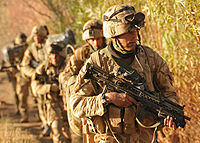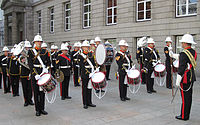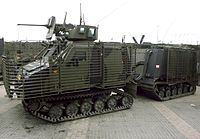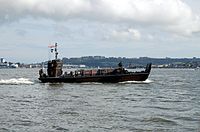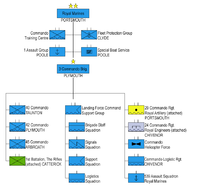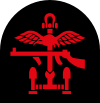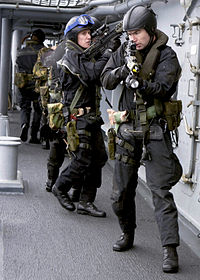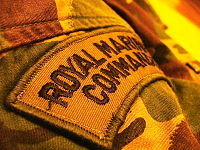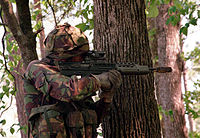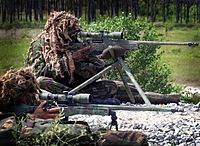
Royal Marines
About this schools Wikipedia selection
SOS Children has tried to make Wikipedia content more accessible by this schools selection. Child sponsorship helps children one by one http://www.sponsor-a-child.org.uk/.
| Royal Marines | |
|---|---|
 Royal Marine Corps Crest |
|
| Active | 1664 – Present |
| Country | |
| Type | Marine Commando |
| Size | 8,600 marines 61 landing craft |
| Part of | Naval Service, British Armed Forces |
| Nickname | Royals Bootnecks The Corps |
| Motto | Per Mare, Per Terram ("By Sea, By Land") |
| March | Quick: " A Life on the Ocean Wave" Slow: "Preobrajensky" |
| Engagements | Second Anglo-Dutch War Third Anglo-Dutch War Williamite War in Ireland War of the Spanish Succession War of Jenkins' Ear Seven Years' War American Revolutionary War War of 1812 Napoleonic Wars Crimean War First Opium War Second Opium War Boxer Rebellion First World War Second World War Korean War Suez Crisis Malayan Emergency Indonesia-Malaysia Confrontation The Troubles Falklands War Persian Gulf War Bosnian War Kosovo War Sierra Leone Civil War Iraq War War in Afghanistan |
| Website | Royal Marines |
| Commanders | |
| Captain-General | HRH The Duke of Edinburgh, KG, KT, OM, GBE, AC, QSO, PC |
| Commandant-General | Major General Ed Davis, CBE |
| Insignia | |
| Commando flash | 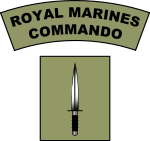 |
| Abbreviation | RM |
The Royal Marine Corps (RM) is the marine corps and amphibious infantry of the United Kingdom and forms part of the Naval Service (along with the Royal Navy, Royal Fleet Auxiliary and associated organisations). The Royal Marines were formed in 1755 as marine infantry for the Royal Navy. However, it can trace its origins back to the formation of "the Duke of York and Albanys maritime regiment of foot" at the grounds of the Honourable Artillery Company on 28 October 1664.
The Royal Marines are a maritime-focused, amphibious, highly specialised light infantry force of commandos. They are capable of deploying at short notice in support of the United Kingdom Government's military and diplomatic objectives overseas. The Royal Marines are organised into a light infantry brigade ( 3 Commando Brigade) and a number of separate units including the Special Boat Service, 1 Assault Group Royal Marines, Fleet Protection Group Royal Marines (previously the Comacchio Group), and a company within the Special Forces Support Group. The Corps operates in all environments and climates, though particular expertise and training is spent on Amphibious warfare, Arctic Warfare, Mountain Warfare, Expeditionary Warfare, Rapid Reaction and supporting Special Forces.
Throughout its history, the Royal Marines have seen action in a number of major wars often fighting beside the British Army – including the Seven Years' War, the Napoleonic Wars, the Crimean War, World War I and World War II. In recent times the Corps has been largely deployed in Expeditionary warfare roles such as the Falklands War, the Gulf War, the Bosnian War, the Kosovo War, the Sierra Leone Civil War, the Iraq War and the War in Afghanistan. The Royal Marines have close international ties with allied marine forces, particularly the United States Marine Corps and the Netherlands Marine Corps/Korps Mariniers.
Today
Personnel
The Royal Marines are part of the naval service and under the full command of Fleet Commander. The rank structure of the corps is similar to that of the British Army with officers and other ranks recruited and initially trained separately from other naval personnel, Women are only permitted to serve in the Royal Marines Band Service. On average, 1,200 recruits and 2,000 potential recruits, and 400 potential officers attend training courses and acquaint courses at CTCRM every year.
As of July 2012 the Royal Marines had a strength of 7,900 regular and approximately 700 Royal Marines Reserve. This gives a combined component strength of around 8,600 personnel, making it slightly larger than the entire Irish Army. The Royal Marines are the only European marine force capable of conducting amphibious operations at brigade level.
Uniforms
For historical information regarding Marine uniforms, see History of the Royal Marines.
The modern Royal Marines retain a number of distinctive uniform items. These include the green "Lovat" service dress worn with the green beret, the dark blue parade dress worn with either the white Wolseley Pattern Helmet (commonly referred to as " pith helmet") or white and red peaked cap, the scarlet and blue mess dress for officers and senior non-commissioned officers and the white hot-weather uniform of the Band Service.
Equipment
Infantry The basic infantry weapon of the Royal Marines is the L85A2 assault rifle, sometimes equipped with an L17A2 underbarrel grenade launcher. Support fire is provided by the L110A1 light machine gun, the L7 General Purpose Machine Gun (GPMG) and the L111A1 Heavy Machine Gun (which is often mounted on an armoured vehicle); indirect fire by the L16 81mm Mortar. Sniper rifles used include the L115A3, produced by Accuracy International. More recently the L129A1 has come into service as the designated marksman rifle. Other weapons include the Javelin Anti-Tank missile, the L107A1+ [Glock 17]. Both semi-automatic pistols and the Fairbairn-Sykes Fighting Knife.
Armour The BvS 10 Viking All Terrain Armoured Vehicle (150 in service) is the primary Armoured fighting vehicle of the Royal Marines. Other vehicles include the Land Rover Wolf Armoured Patrol Vehicle, the Jackal (MWMIK) Armoured Vehicle and the Pinzgauer High Mobility All Terrain Vehicle.
Artillery Artillery support is provided by the 29 Commando Regiment Royal Artillery of the British Army utilizing the L118 Light Gun, a 105 mm towed howitzer.
Aviation The Royal Air Force and Fleet Air Arm provide transport and attack helicopters in support of the Royal Marines. It uses both Sea King transport and Lynx attack helicopters from the Fleet Air Arm to provide direct aviation support for the Corp. However, the air force additionally provides Chinook heavy-lift, Merlin HC3 and Puma HC1 medium-lift transport helicopters.
Vessels The Royal Marines operate a varied fleet of small craft designed to transport troops from ship to shore or conduct river or estuary patrols. These include Griffon 2000 TDX Hovercraft, MK9 and MK10 Landing Craft Utility and MK4 and MK5 Landing Craft Vehicle Personnel as well as SDV Mk8 Mod 1 Mini-submarines for special forces and various smaller craft.
Formation and structure
The overall head of the Royal Marines is Her Majesty Queen Elizabeth II, in her role as Commander-in-Chief of the British Armed Forces. The ceremonial head of the Royal Marines is the Captain General Royal Marines (equivalent to the Colonel-in-Chief of a British Army regiment). The current Captain-General is Prince Philip, Duke of Edinburgh. Full Command of the Royal Marines is vested in the Commander-in-Chief Fleet (CINCFLEET) with the Commandant-General Royal Marines, a Major-General, embedded within the CINCFLEET staff as Commander UK Amphibious Force (COMUKAMPHIBFOR).
The operational capability of the Corps comprises a number of Battalion-plus sized units, of which five are designated as "Commandos":
- 40 Commando (known as Forty Commando) based at Norton Manor Barracks, Taunton, Somerset, England
- 42 Commando (known as Four Two Commando) based at Bickleigh Barracks, Plymouth, Devon, England
- 43 Commando Fleet Protection Group Royal Marines based at HM Naval Base Clyde, Helensburgh, Argyll and Bute (Previously Comacchio Group).
- 45 Commando (known as Four Five Commando) based at RM Condor, Arbroath, Angus, Scotland
- 30 Commando Information Exploitation Group based at Stonehouse Barracks, Plymouth
- Commando Logistic Regiment based at Chivenor, Devon
- Special Boat Service based at RM Poole, Dorset (although Full Command is retained by CINCFLEET, Operational Command of SBS RM is assigned to Director Special Forces).
- 1 Assault Group Royal Marines based at RM Poole, Dorset.
With the exception of the Fleet Protection Group and Commando Logistic Regiment, which are each commanded by a full Colonel, each of these units is commanded by a Lieutenant-Colonel of the Royal Marines, who may have sub-specialised in a number of ways throughout his career. There is also a Mountain Leader Training Cadre based at Lympstone Commando Training Centre, Lympstone, Devon.
3 Commando Brigade
Operational Command of the five Commandos and the Commando Logistics Regiment is delegated to 3 Commando Brigade Royal Marines, of which they are a part. Based at Stonehouse Barracks, the brigade exercises control as directed by either CINCFLEET or the Permanent Joint Headquarters. As the main combat formation of the Royal Marines, the brigade has its own organic capability to it in the field, 30 Commando Information Exploitation Group, a battalion sized formation providing information operations capabilities, life support and security for the Brigade Headquarters.
43 Commando Fleet Protection Group Royal Marines, responsible for the security of the United Kingdom's nuclear deterrent and other security-related duties was originally outside the brigade however from April 2012 it moved into it. It also provides specialist boarding parties and snipers for the Royal Navy worldwide, for roles such as embargo enforcement, counter-narcotics, counter-piracy and counter-insurgency activities of the Royal Navy. It is the largest unit in the brigade at 790 strong with a different structure from the other Commandos.
Independent elements
The independent elements of the Royal Marines are:
- Commando Training Centre: This is the training unit for the entire corps, and consists of three separate sections:
- Commando Training Wing: This is the initial basic commando training section for new recruits to the Royal Marines, and the All Arms Commando Course.
- Specialist Wing: This provides specialist training in the various trades which Marines may elect to join once qualified and experienced in a Rifle Company.
- Command Wing: This provides command training for both officers and NCOs of the Royal Marines.
- 1 Assault Group Royal Marines: Provides training in the use of landing craft and boats, and also serves as a parent unit for the three assault squadrons permanently embarked on the Royal Navy's amphibious ships.
- 4 Assault Squadron— HMS Bulwark
- 6 Assault Squadron— HMS Albion
- 9 Assault Squadron— HMS Ocean
- Special Boat Service (SBS) are naval special forces and under operational command of Director Special Forces. It is commanded by a Lieutenant Colonel qualified as a Swimmer Canoeist. SBS Responsibilities include water-borne operations, Maritime Counter-Terrorism and other special forces tasks.
- Royal Marines Band Service provides regular bands for the Royal Navy and provides expertise to train RN Volunteer Bands. Musicians have a secondary role as field hospital orderlies. Personnel may not be commando trained, wearing a blue beret instead of green; the band service is the only branch of the Royal Marines which admits women.
Structure of a Commando
The three Commando units are each organised into six companies, further organised into platoon-sized troops, as follows; A Command Company; Main HQ, Tactical HQ, Reconnaissance Troop with a sniper section, Mortar Troop, Anti-Tank (AT) Troop, Medium Machine Gun Troop. A Logistic Company; A Echelon 1, A Echelon 2, FRT (Forward Repair Team), RAP (Regimental Aid Post), B Echelon. Two Close Combat Companies; Company Headquarters, Three Close Combat Troops and Two Stand Off Companies; Company Headquarters, Heavy Machine Gun (HMG) Troop, AT Troop, Close Combat Troop.
In general a rifle company Marine will be a member of a four-man fire team, the building block of commando operations. A Royal Marine works with his team in the field and shares accommodation if living in barracks. This structure is a recent development, formerly Commandos were structured similarly to British Army light Infantry Battalions. During the restructuring of the United Kingdom's military services the Corps evolved from a Cold War focus on NATO's Northern Flank towards a more expeditionary posture.
Amphibious Task Group
Formerly known as the Amphibious Ready Group, the Amphibious Task Group (or ATG) is a mobile, balanced amphibious warfare force, based on a Commando Group and its supporting assets, that can be kept at high readiness to deploy into an area of operations. The ATG is normally based around specialist amphibious ships, most notably HMS Ocean, the largest ship in the British fleet. Ocean was designed and built to accommodate an embarked commando and its associated stores and equipment. The strategy of the ATG is to wait "beyond the horizon" and then deploy swiftly as directed by HM Government. The whole amphibious force is intended to be self-sustaining and capable of operating without host-nation support. The concept was successfully tested in operations in Sierra Leone.
Commando Helicopter Force
The Commando Helicopter Force forms part of the Fleet Air Arm. The force comprises four helicopter squadrons and is commanded by the Joint Helicopter Command. It consists of both Royal Navy (RN) and Royal Marines personnel. RN personnel need not be commando trained. The Commando Helicopter Force is neither under the permanent control of 3 Commando Brigade nor that of the Commandant General Royal Marines but rather is allocated to support Royal Marines units as required. It uses both Sea King transport and Lynx Light lift helicopters to provide aviation support for the Royal Marines.
Selection and Training
Royal Marines are required to undergo one of the longest and most physically demanding specialist infantry training regimes in the world. Recruit training lasts for 32 weeks for Marines and 64 weeks for officers. Potential recruits must first undertake a series of interviews, medical tests, an eye/sight test, psychometric tests and a PJFT (Pre-joining fitness test). Once a potential recruit passes these, enlisted recruits undertake a 3-day selection course called PRMC (Potential Royal Marine Course) and potential officers undertake POC (Potential Officer Course) - both take place at the Commando Training Centre Royal Marines (CTCRM) in Lympstone, Devon. Officers must also take the Admiralty Interview Board (AIB). Upon passing the 3-day course, recruits then start basic recruit training (RT) at CTCRM. Unlike many countries, enlisted Marines and officer Marines often train together for the first 32 weeks. A large proportion of training is carried out on Dartmoor's inhospitable terrain and Woodbury Common woodland. The culmination of their training ends with their infamous commando courses which they initially pre-train for. The commando courses are a series of physical and mental endurance tests that highlight their military professionalism.
Throughout the recruit training, Royal Marines learn and develop many military skills such as weapons handling, marksmanship and proficiency with different firearms, personal administration, marching and parade ground skills, map reading and navigation, physical fitness and mental toughness development, fieldcraft skills such as camouflage and stalking, basic survival techniques, patrolling and sentry duty development, unarmed and armed close quarters combat (CQC), first aid, underwater escape, chemical biological radiological nuclear (CBRN) training, military communications and signals, teamwork skills, amphibious landings training, and leadership skills for officers to name a few.
Throughout his career, a Marine can specialise in a number of different roles upon completion of their respective courses after spending 1–2 years as a general duties (GD) Marine. Examples of some specialisations and different courses includes the mountain leader (ML), physical training instructor (PTI), military police (MP), sniper course, medical assistant, pilot, reconnaissance operator (RO), drill instructor, driver, clerk, chef, signaller, combat intelligence, armourer, and heavy weapons training. Royal Marines can also apply for swimmer canoeist/ Special Boat Service selection (SBS) or any other branch of the UKSF. All Royal Marines will also conduct training exercises on differing military skills on a regular basis including development in mountain, arctic, jungle, amphibious and desert warfare. They can also be involved in exchange training programs with other countries forces – particularly the United States Marine Corps and the Netherlands Marine Corps/Korps Mariniers.
Customs and traditions
The Royal Marines have a proud history and unique traditions. With the sole exception of "Gibraltar", their colours (flags) do not carry battle honours in the manner of the regiments of the British Army or of the US Marine Corps, but rather the "globe itself" as a symbol of the Corps. This reflects their engagement, from aboard ship, in a host of naval battles and skirmishes, and amphibious actions, wherever the Royal Navy fought in the age of sail.
The heraldic crest of the Royal Marines commemorates the history of the Corps. The Lion and Crown denotes a Royal regiment. King George III conferred this honour in 1802 "in consideration of the very meritorious services of the Marines in the late war." The "Great Globe itself" surrounded by laurels was chosen by King George IV as a symbol of the Marines' successes in every quarter of the world. The laurels are believed to honour the gallantry they displayed during the investment and capture of Belle Isle, off Lorient, in April–June 1761. The word Gibraltar refers to the Great Siege of Gibraltar by French and Spanish forces, from 1779 to 1783, in support of the American Revolution. It was awarded in 1827 by George IV as a special distinction for the services of four of the old Army Marine regiments (Queen's Own Marines, 1st Marines, 2nd Marines, 3rd Marines) in holding that fortress against determined assaults, despite extreme privation. There are no other battle honours displayed on the colours of the four battalion-sized units of the current Corps. The Latin motto "Per Mare Per Terram" translates into English as "By Sea By Land" describing how the Royal Marines both attack and defend. The fouled anchor, incorporated into the emblem in 1747, is the badge of the Lord High Admiral and shows that the Corps is part of the Naval Service. Per Mare Per Terram ("By Sea By Land"), the motto of the Marines, is believed to have been used for the first time in 1775.
When referring to individual Commandos: 45 Commando is referred to as "four-five" rather than "forty-five commando" as is 42 Commando, 40 Commando is "forty". The only units which carry colours are 40 Commando, 42 Commando, 45 Commando, and the Fleet Protection Group (which is the custodian of the colours of 43 Commando).
The regimental quick march of the Corps is " A Life on the Ocean Wave", while the slow march is the march of the Preobrazhensky Regiment, awarded to the Corps by Admiral of the Fleet Earl Mountbatten of Burma on the occasion of the Corps's tercentenary in 1964. Lord Mountbatten was Life Colonel Commandant of the Royal Marines until his murder by the IRA in 1979.
Dress headgear is a white Wolseley pattern pith helmet surmounted by a ball, a distinction once standard for artillerymen. This derives from the part of the Corps that was once the Royal Marine Artillery. Their nickname "Bootneck" derives its origins from the leather 'stock' worn round the neck inside the collar by soldiers (cf. Leatherneck).
The Royal Marines are one of six regiments allowed by the Lord Mayor of the City of London to march through the City as a regiment in full array. This dates to the charter of Charles II that allowed recruiting parties of the Admiral's Regiment of 1664 to enter the City with drums beating and colours flying.
Order of precedence
As the descendant of the old Marine Regiments of the British Army, the Royal Marines used to have a position in the order of precedence of the Infantry; this was after the 49th Regiment of Foot, the final lineal descendant of which was the Royal Gloucestershire, Berkshire and Wiltshire Regiment. Therefore, the Royal Marines would have paraded after the RGBW. This is because the 49th Foot was the last Regiment raised prior to the formation of the Corps of Marines as part of the Royal Navy in 1755. In 2007, the RGBW was amalgamated into a large Regiment—this new Regiment is placed last in the order of precedence, as it is a regiment of rifles. However as a result of the new Army amalgamations the Royal Marines have now been removed from the Infantry order of precedence and will now always take post, as a constituent part of the Naval Service, at the head of the parade alongside the Navy, or alone if the Navy are not represented. Thus, if only the infantry is represented, the Royal Marines would parade before the Grenadier Guards, the senior infantry regiment in the Army.
| Preceded by As part of Naval Service, assumes precedence before all Army units |
Infantry order of precedence | Succeeded by Grenadier Guards |
Affiliations
Argyll and Sutherland Highlanders
Early connections date from Balaclava in the Crimean War and Lucknow during the Indian Mutiny, but the main association stems from World War II. In July 1940, after the fall of Dunkirk, the 5th Battalion, Argyll and Sutherland Highlanders served with the Royal Marine Brigade for over a year. When the battleships HMS Prince of Wales and Repulse were sunk in December 1941, the Royal Marines survivors joined up with the remnants of the 2nd Battalion, in the defence of Singapore. They formed what became known as 'The Plymouth Argylls', after the association football team, since both ships were Plymouth manned. Most of the Highlanders and Marines who survived the bitter fighting were taken prisoner by the Japanese. The Royal Marines inter-unit rugby football trophy is the 'Argyll Bowl', presented to the Corps by the Regiment in 1941. A message of greetings is sent to the Regiment each year on their Regimental Day, 25 October, the anniversary of the Battle of Balaclava in 1854.
The Princess of Wales's Royal Regiment
The fore-bearer regiments of the The Princess of Wales's Royal Regiment, The East Surrey Regiment (Villier's Marines) was initially raised as amphibious troops. They served as Marines for a period. To this day one officer from the Royal Marine serves with the PWRR and Vice Versa. Also the Royal Marine Lanyard is worn by all ranks in Service Dress and Number 2 Dress uniform and barrack dress of PWRR

